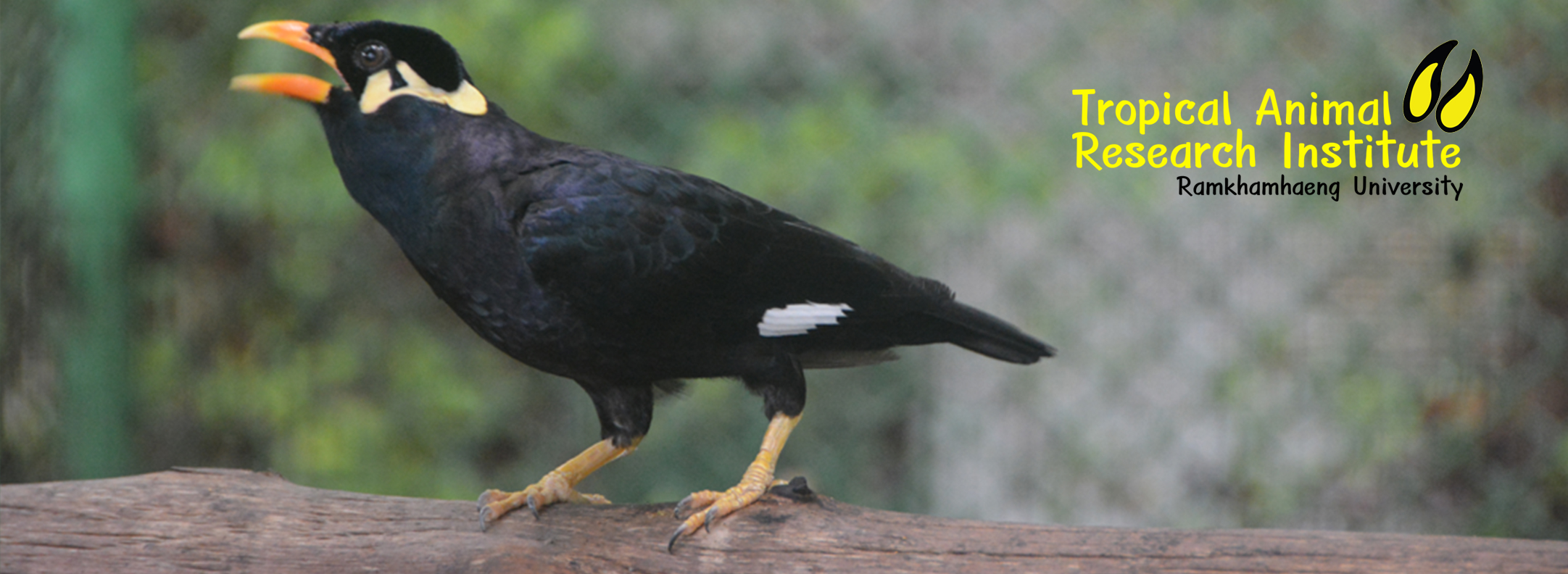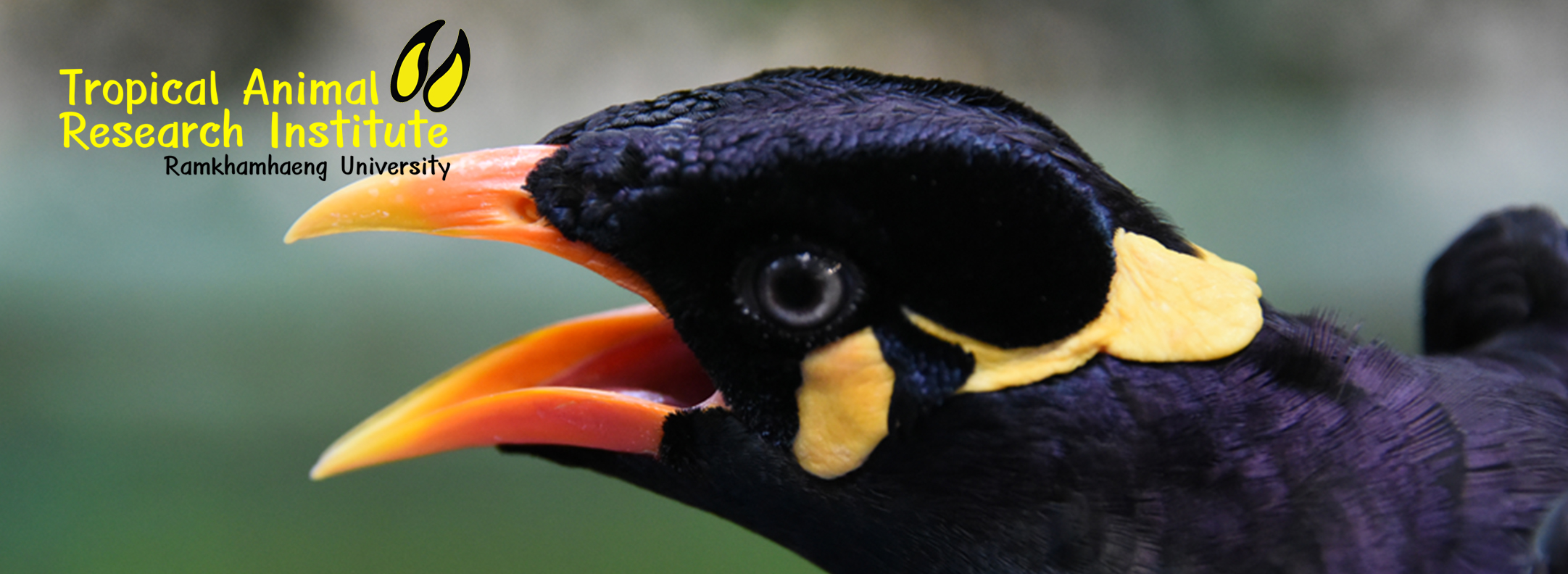
About The Hill Mynah
in Thailand
“The Hill Mynah in Thailand: A 30-year Study. Behavioral Ecology, Evolution, and Conservation Biology” is an integration of the field, experimental, and laboratory studies conducted from 1987 to 2017 on Gracula religiosa, the hill myna or for simplicity in this book, the hill mynah. These studies were first inspired by the need to enhance knowledge on the tropical bird species inhabiting South-East Asia. Most behavioral ecology, evolutionary, and conservation biology concepts on birds are based on studies concerning temperate species. Efficient wildlife conservation operations are generally based on information achieved by examining the life history, evolution, and behavior of that particular species and/or its relatives. Therefore, studying and revealing the life history of hill mynah allowed developing a practical conservation program for this species.
Why is the Hill Mynah Studied?
Hill mynahs have bright yellow wattles on both sides of their heads and lustrous black feathers that, when reflected in the sunlight, appear glossy with a tinge of dark blue or deep purple. Besides their unique coloration, hill mynahs have a remarkable talent. They are able to recall and mimic sounds, even human words or phrases that they had heard years earlier. This attribute makes them highly desirable as a pet. However, caged hill mynahs rarely breed, and hence, the caged population is unable to keep up with the demand of the pet trade, resulting in continual poaching of wild-born nestlings. Moreover, the destruction of deforestation goes far beyond the obvious. For birds, this leads to a decrease in suitable areas for nesting and food sources. The preservation of native forests is of a lower priority to the human element, and because deforestation impacts bird species in the long-term, it serves as another major threat to the hill mynah.
The 30-year study conducted for hill mynah covered diverse topics that, together with its life history, completed the necessary knowledge to implement conservation management policies for the hill mynah in Thailand. This book thus compiles all studies on hill mynah, including its anatomy, behavior, conservation biology, cytogenetic, ecology, endocrinology, entomology, evolution, forest biology, hematology, molecular biology, ornithology, parasitology, population biology, reproductive physiology, sociobiology, and zoogeography. Therefore, this book is a compilation of the data that were obtained from the research conducted on hill mynahs in Thailand: in nature, in aviaries, and in laboratory experiments, under various titles for the past 30 years from 1987 to 2017.
The Hill Mynah Study
Hill mynah is a monomorphic bird. Although the first study on this species, in 1987, considered sex determination, further methods were developed until 2004. Currently, it is possible to determine hill mynah sex using six methods. The long-term study of hill mynah in its natural habitat, i.e. in the forest, started in 1990. Its reproduction, nesting success, and habitat characteristics were investigated for 10 years (1990 to 1999), and the effects of habitat loss on its nesting success were studied for five years (2009–2013). Morphological variations within a population were studied in two periods, covering 11 years: 1993–2000 and 2013–2015. The mating behavior and survival of hill mynah in natural habitats were also recorded in two periods, covering nine years: 1997–2002 and 2013–2015. These studies were conducted in two periods to re-investigate the dynamics of the variations found in the first periods, to assess the influence of ecosystem fluctuations on the life history of hill mynah.
Experimental and laboratory researches were also long. Captive breeding started in 1995, was first successful in 1997, and continuously practiced until present (2020). The study of hill mynah hormones was performed in 1995–1996 and its parasites were investigated in 2002–2003. Long-term experiments in captivity regarding vocal mimicry were conducted for seven years (1996–2002), and the monogamous mating system was examined for 10 years (2006–2015). Molecular biology is very popular nowadays to investigate evolutionary relationships, behavior, morphology, and adaptive selection in several bird species. Molecular biology studies on hill mynah were performed in two periods totalizing ten years: 1999–2004 and 2014–2017.
Long-term studies allow confirming data repeatedly, which is an advantage. Although analyzing such massive data is time-consuming, reliable information is confidently achieved. “The Hill mynah in Thailand: A 30-year Study. Behavioral Ecology, Evolution and Conservation Biology” not only compiles the diverse knowledge about hill mynah, but also facilitates the future study of other tropical bird species that are relatives to hill mynah. Interestingly, the long-term study of hill mynah under such diverse perspectives also contributes for better understanding tropical bird species. Moreover, the success of conservation programs for tropical birds is expected to increase because the basic understanding of their life histories will also be enhanced.
About The Hill Mynah
in Thailand
“The Hill Mynah in Thailand: A 30-year Study. Behavioral Ecology, Evolution, and Conservation Biology” is an integration of the field, experimental, and laboratory studies conducted from 1987 to 2017 on Gracula religiosa, the hill myna or for simplicity in this book, the hill mynah. These studies were first inspired by the need to enhance knowledge on the tropical bird species inhabiting South-East Asia. Most behavioral ecology, evolutionary, and conservation biology concepts on birds are based on studies concerning temperate species. Efficient wildlife conservation operations are generally based on information achieved by examining the life history, evolution, and behavior of that particular species and/or its relatives. Therefore, studying and revealing the life history of hill mynah allowed developing a practical conservation program for this species.
Why is the Hill Mynah Studied?
Hill mynahs have bright yellow wattles on both sides of their heads and lustrous black feathers that, when reflected in the sunlight, appear glossy with a tinge of dark blue or deep purple. Besides their unique coloration, hill mynahs have a remarkable talent. They are able to recall and mimic sounds, even human words or phrases that they had heard years earlier. This attribute makes them highly desirable as a pet. However, caged hill mynahs rarely breed, and hence, the caged population is unable to keep up with the demand of the pet trade, resulting in continual poaching of wild-born nestlings. Moreover, the destruction of deforestation goes far beyond the obvious. For birds, this leads to a decrease in suitable areas for nesting and food sources. The preservation of native forests is of a lower priority to the human element, and because deforestation impacts bird species in the long-term, it serves as another major threat to the hill mynah.
The 30-year study conducted for hill mynah covered diverse topics that, together with its life history, completed the necessary knowledge to implement conservation management policies for the hill mynah in Thailand. This book thus compiles all studies on hill mynah, including its anatomy, behavior, conservation biology, cytogenetic, ecology, endocrinology, entomology, evolution, forest biology, hematology, molecular biology, ornithology, parasitology, population biology, reproductive physiology, sociobiology, and zoogeography. Therefore, this book is a compilation of the data that were obtained from the research conducted on hill mynahs in Thailand: in nature, in aviaries, and in laboratory experiments, under various titles for the past 30 years from 1987 to 2017.
The Hill Mynah Study
Hill mynah is a monomorphic bird. Although the first study on this species, in 1987, considered sex determination, further methods were developed until 2004. Currently, it is possible to determine hill mynah sex using six methods. The long-term study of hill mynah in its natural habitat, i.e. in the forest, started in 1990. Its reproduction, nesting success, and habitat characteristics were investigated for 10 years (1990 to 1999), and the effects of habitat loss on its nesting success were studied for five years (2009–2013). Morphological variations within a population were studied in two periods, covering 11 years: 1993–2000 and 2013–2015. The mating behavior and survival of hill mynah in natural habitats were also recorded in two periods, covering nine years: 1997–2002 and 2013–2015. These studies were conducted in two periods to re-investigate the dynamics of the variations found in the first periods, to assess the influence of ecosystem fluctuations on the life history of hill mynah.
Experimental and laboratory researches were also long. Captive breeding started in 1995, was first successful in 1997, and continuously practiced until present (2020). The study of hill mynah hormones was performed in 1995–1996 and its parasites were investigated in 2002–2003. Long-term experiments in captivity regarding vocal mimicry were conducted for seven years (1996–2002), and the monogamous mating system was examined for 10 years (2006–2015). Molecular biology is very popular nowadays to investigate evolutionary relationships, behavior, morphology, and adaptive selection in several bird species. Molecular biology studies on hill mynah were performed in two periods totalizing ten years: 1999–2004 and 2014–2017.
Long-term studies allow confirming data repeatedly, which is an advantage. Although analyzing such massive data is time-consuming, reliable information is confidently achieved. “The Hill mynah in Thailand: A 30-year Study. Behavioral Ecology, Evolution and Conservation Biology” not only compiles the diverse knowledge about hill mynah, but also facilitates the future study of other tropical bird species that are relatives to hill mynah. Interestingly, the long-term study of hill mynah under such diverse perspectives also contributes for better understanding tropical bird species. Moreover, the success of conservation programs for tropical birds is expected to increase because the basic understanding of their life histories will also be enhanced.
From the Back Cover The Hill Mynah in Thailand
“This delightfully illustrated book presents the results of a 30-year study of a well known yet fascinating bird. It describes the challenges for tropical forest conservation so critical for the preservation of this and other species. It also makes a strong case for ongoing hybridization between northern and southern populations of hill mynahs, documents the critical importance of the male for reproductive success in this monogamous species, and provides new information about the role of mimicry in its social behavior. All those interested in tropical ornithology or conservation will find important insights here.”
Professor Dr. R. Haven Wiley, Biology Department, The University of North Carolina at Chapel Hill, North Carolina, U.S.A.
“In my experience this book is the most comprehensive on hill mynah especially for those working in this species conservation. Not only does it give good information about in situ conservation but also ex situ work. I really recommend whoever conducts hill mynah conservation and other tropical songbird, or even only want to do captive breeding program, to use this book for reference”
Drh. I Gede Nyoman Bayu Wirayudha, CEO of Friends of the National Parks Foundation, Indonesia.
“This excellent book documents and references the great majority of what is known about the hill mynahs of Thailand and elsewhere in the wild as well as in captivity including but not limited to taxonomy, nutrition, anatomy, physiology, genetics, breeding, habitat destruction, and theft of wild bred birds. Each chapter of the book is precisely written summarizing the findings of years of related research by others as well as that supervised by the author into the spectrum of disciplines impacting these birds. It is liberally illustrated by sketches, photos, charts and maps. The author Dr. Manee is to be applauded and congratulated on this mammoth work that will serve as the main reference for many years on tropical bird ecology and more.”
Dr. Ross Perry, Holistic Veterinarian and Avian Health Specialist, New South Wales, Australia.
“This is a very comprehensive book born from a long and exhaustive research. It has a unique section on the bird’s ability to mimic, and details regarding subspecies differentiation. This book provides clear guidance for those interested in breeding the hill mynah or relative species. It is easy to understand both for scientists and lay people. This book will serve as a good template for other species research, especially those with subspecies.”
Professor Dr. Sudaryanto Sudaryanto, Department of Biology, Udayana University, Indonesia
“This delightfully illustrated book presents the results of a 30-year study of a well known yet fascinating bird. It describes the challenges for tropical forest conservation so critical for the preservation of this and other species. It also makes a strong case for ongoing hybridization between northern and southern populations of hill mynahs, documents the critical importance of the male for reproductive success in this monogamous species, and provides new information about the role of mimicry in its social behavior. All those interested in tropical ornithology or conservation will find important insights here.”
Professor Dr. R. Haven Wiley, Biology Department, The University of North Carolina at Chapel Hill, North Carolina, U.S.A.
“In my experience this book is the most comprehensive on hill mynah especially for those working in this species conservation. Not only does it give good information about in situ conservation but also ex situ work. I really recommend whoever conducts hill mynah conservation and other tropical songbird, or even only want to do captive breeding program, to use this book for reference”
Drh. I Gede Nyoman Bayu Wirayudha, CEO of Friends of the National Parks Foundation, Indonesia.
“This excellent book documents and references the great majority of what is known about the hill mynahs of Thailand and elsewhere in the wild as well as in captivity including but not limited to taxonomy, nutrition, anatomy, physiology, genetics, breeding, habitat destruction, and theft of wild bred birds. Each chapter of the book is precisely written summarizing the findings of years of related research by others as well as that supervised by the author into the spectrum of disciplines impacting these birds. It is liberally illustrated by sketches, photos, charts and maps. The author Dr. Manee is to be applauded and congratulated on this mammoth work that will serve as the main reference for many years on tropical bird ecology and more.”
Dr. Ross Perry, Holistic Veterinarian and Avian Health Specialist, New South Wales, Australia.
“This is a very comprehensive book born from a long and exhaustive research. It has a unique section on the bird’s ability to mimic, and details regarding subspecies differentiation. This book provides clear guidance for those interested in breeding the hill mynah or relative species. It is easy to understand both for scientists and lay people. This book will serve as a good template for other species research, especially those with subspecies.”
Professor Dr. Sudaryanto Sudaryanto, Department of Biology, Udayana University, Indonesia


















